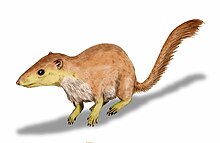Purgatorius unio
|
Purgatorius Temporal range: Late Cretaceous-Paleocene, 66–63 Ma |
|
|---|---|
 |
|
| Life restoration of P. unio | |
| Scientific classification | |
| Kingdom: | Animalia |
| Phylum: | Chordata |
| Class: | Mammalia |
| Clade: | Eutheria |
| Genus: |
†Purgatorius Valen & Sloan, 1965 |
| Type species | |
|
†Purgatorius unio Valen & Sloan, 1965 |
|
| Species | |
|
|
Purgatorius is the genus of the four extinct eutherian species typically (and erroneously; see below) believed to be the earliest example of a primate or a proto-primate, a primatomorph precursor to the Plesiadapiformes, dating to as old as 66 million years ago. The first remains (P. unio and P. ceratops) were reported in 1965, from what is now eastern Montana's Tullock Formation (early Paleocene, Puercan), specifically at Purgatory Hill (hence the animal's name) in deposits believed to be about 63 million years old, and at Harbicht Hill in the late Cretaceous and lower Paleocene Hell Creek Formation. Both locations are in McCone County.
They have also been widely discovered in the early Paleocene Bug Creek fauna, along with leptictids. These deposits were once thought to be latest Cretaceous, but it is now clear that they are Paleocene channels with time-averaged fossil assemblages. It is thought to have been rat-sized 6 in (15 cm) long and 1.3 ounces (about 37g) and a diurnal insectivore, who burrowed through small holes in the ground.
Postcanine dentition of P. unio is documented by 13 dentulous, fragmentary mandibles, a fragmentary maxillary and more than 50 isolated teeth from Garbani Locality 80 km west of Purgatory Hill. P. ceratops is represented by an isolated lower molar found at Harbicht Hill, McCone County. The report of the occurrence of Purgatorius in the Late Cretaceous was based on an isolated, worn molar found in a channel filling that contains early Puercan fossils. It is also abundantly represented in Pu 2-3 local faunas in the northern Western interior, suggesting that it came into the area between 64.75 and 64.11 Mya. Fragmentary dentition from the Garbani Channel fauna from Purgatorius janisae shows that the lower dental formula was 3.1.4.3.
The type specimen of P. unio, a damaged upper molar, is essentially identical to teeth found at the Garbani Locality. Data from this sample support Van Valen and Sloan's identification of topotypic lower molars, and also demonstrate that the lower dentition of P. unio includes seven postcanines. The alveolus for the single root of P1, crown unknown, is smaller than those for the canine or P2. The second lower pre- molar is smaller than P3; both are two- rooted. The fourth lower premolar is submolariform. A metaconid is lacking, although on some teeth slight thickenings of the enamel are present in this region. Talonid cusps are slightly differentiated. The first and second lower molars are approximately the same length (M1, average length x=- 1.93 mm, N- 13; M2, x=2.00 mm, N- 9); M. is longer (x= 2.32 mm, N -7). Widths of talonids of M1.2 vary from less than to greater than widths of trigonids. Hypoconulid of M. is enlarged, salient, and on some teeth incipiently doubled by addition of a lingual cusp.
...
Wikipedia
